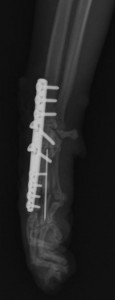 A four-year-old female neutered Burmese cat with a taste for adventure made headlines this month after sustaining massive injuries secondary to “high rise syndrome”. The apartment-dwelling cat, named Akira, fell off a window ledge, plunging eight floors onto a driveway late on a Saturday night.
A four-year-old female neutered Burmese cat with a taste for adventure made headlines this month after sustaining massive injuries secondary to “high rise syndrome”. The apartment-dwelling cat, named Akira, fell off a window ledge, plunging eight floors onto a driveway late on a Saturday night.
“She was just lying there sort of splattered on the driveway,” owner April Twyford told The Daily Telegraph. “She actually left a bit of a mark when we scraped her up.”
Akira presented to the Veterinary Specialist Centre at North Ryde with extensive injuries, including a mild pneumothorax and lung contusions, haematuria, non-displaced fractures of both temporomandibular joints, a luxated left elbow, bilateral metacarpal fractures, subluxation of the right carpometacarpal joints and a small chip on her caudal glenoid. The VSC’s team of emergency vets worked around the clock to stabilise Akira before surgery.
According to surgeon Martin Havlicek, high rise syndrome is a not an uncommon presentation at specialist centres like the VSC.
“We see them fairly frequently, the injuries depend on the height of the fall as well as whether they land on concrete or in bushes, sometimes they hit a window ledge.”
Common injuries include head trauma, fracture of the hard palate, mandibular and maxillary fractures and pulmonary contusions.
What was unusual about Akira was the combination of metacarpal fractures with palmar luxation of the carpometacarpal bones.
“We were able to perform a closed reduction of the elbow and stabilise the left metacarpus with pins but because of the derangements on the right hand side we had to perform a pancarpal arthrodesis.”
Akira, whose owner feels she has lost one life for each floor, has improved exponentially.
“Akira is very comfortable and ambulating on her forelimbs,” Havlicek said.
Both of her forelimbs are supported by modified Robert Jones bandages with back splints.
In a retrospective study of 119 cats suffering from high rise syndrome published in the Journal of Feline Medicine and Surgery, only 38.5 per cent of cats sustained forelimb fractures, like Akira, compared with 61.5 per cent which sustained hindlimb fractures. The most common fractures included tibial fractures (36.4 per cent) followed by femoral fractures (23.6 per cent). Thoracic trauma was diagnosed in one third of affected cats, with 20 per cent diagnosed with pneumothorax of varying severity and 13.4 per cent sustaining pulmonary contusions. Not surprisingly, the majority of cats (approximately 60 per cent) were under twelve months of age. Falls from the seventh floor of above were associated with more severe injuries and a higher incidence of thoracic trauma.
Cats that suffer head and facial trauma frequently need feeding tubes, but Akira proved very easy to assist-feed in hospital.
“She was licking Hills Feline a/d from the syringe before the operation and ate voluntarily 24 hours after the surgery,” Havlicek said.
REFERENCE
Vnuk D, Pirkic B, Maticic D, Radisic B, Steiskal M, Babic T, Kreszinger M and Lemo N (2004) Feline high rise syndrome: 119 cases (1998-2001). 6(5):305-12.
– ANNE FAWCETT

